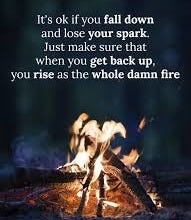What It Means to “Lose Your Spark”, And How to Find It Again
Have you ever looked in the mirror and thought: "Where did that excited, driven version of me go?"
The version who once dreamed wildly, woke up with purpose, and felt lit from within.
If you’ve asked yourself that question, you’re not alone.
We don’t often talk about it, but many of us at some point in adulthood, quietly lose our spark.
It happens gradually.
You wake up feeling unmotivated.
You scroll endlessly but feel nothing.
You smile, but it doesn’t quite reach your eyes.
You’re busy but not fulfilled.
You’re surviving but not thriving.
This state of existing rather than living can be deeply unsettling. But what exactly is this "spark" we feel we’ve lost?
Defining the “Spark”
The “spark” isn’t just about passion or motivation. It’s a deep, internal flame that fuels our:
Sense of identity
Purpose
Creativity
Connection to life
It's what makes us feel alive.
The spark is what pulls us out of bed with anticipation.
It’s what lights our eyes when we talk about something we love.
It’s what gives us the courage to take risks, follow curiosity, and move with intention.
To lose that spark is to feel disconnected from yourself.
How Do We Lose It?
Losing your spark rarely happens overnight. It’s often the result of:
1. Chronic Stress & Burnout
High expectations, long work hours, financial pressure, caregiving, or unrelenting demands slowly wear down your emotional reserves. You keep going out of necessity, but the light dims inside.
Real-life example:
Maria, a once-passionate teacher, found herself going through the motions after years of curriculum changes, oversized classes, and emotional exhaustion. “I used to love teaching,” she said. “Now, I just count the hours.”
2. Living Out of Alignment
When your daily actions contradict your values or desires, whether it’s staying in a job you hate, pleasing everyone but yourself, or ignoring your creative instincts you start to lose your spark.
You’re not just tired; you’re tired of yourself.
3. Unprocessed Grief or Trauma
Loss, whether of a person, a dream, or your former self can shift your emotional landscape. The spark dims when pain is buried instead of processed.
4. Lack of Joy or Novelty
The brain thrives on novelty, learning, and growth. Repeating the same routine with no mental stimulation can cause your inner world to stagnate.
Why Losing Your Spark Feels So Personal
Because the spark is you, your essence, your energy, your truth, its absence feels like grief.
You mourn the person you used to be.
You question: Is this all there is?
What makes it harder is that from the outside, things might look fine.
You may have a job, family, friends, and goals.
But if your inner world feels dull and dim, that external success can feel hollow.
The Hidden Gift in Losing Your Spark
Here’s the paradox:
Losing your spark might be painful but it’s often a turning point.
It’s your soul’s way of saying: This is no longer working. Something needs to change.
It’s a wake-up call.
Instead of seeing it as a breakdown, what if it’s an invitation to rediscover who you are now?
You’re not meant to stay the same version of yourself forever.
How to Begin Rekindling Your Spark
1. Acknowledge It Without Shame
You don’t need to perform happiness. You don’t need to justify your emptiness.
Say it out loud:
“I feel like I’ve lost myself. And I want to find me again.”
Honesty is the beginning of clarity.
2. Start Asking Yourself Better Questions
Instead of “What’s wrong with me?” try:
What used to excite me and what happened to that?
Where do I feel out of alignment in my life?
What small things bring me peace, even if just for a moment?
These questions move you from self-judgment to self-inquiry.
3. Revisit Your “Spark History”
Look back at your life and identify moments when you felt most alive. Not just happiest but deeply connected, joyful, in flow.
What were you doing? Who were you with? What values were you expressing?
These memories hold clues to what still matters.
4. Reconnect to Your Body
The spark lives in your body before your mind. Start with somatic practices like:
Walking in nature
Dancing to music
Gentle stretching or yoga
Deep breathing
These practices regulate your nervous system and create space for clarity to return.
5. Create Micro-Moments of Joy
Don’t wait for a big revelation or change. Look for tiny flickers of joy in your day:
A cup of tea in silence
Journaling your thoughts
Lighting a candle at night
Laughing at a silly video
Texting someone who “gets” you
Joy builds momentum.
6. Limit What Drains You
Audit your digital intake, energy leaks, and toxic patterns.
Every “yes” you say to what drains you is a “no” to your spark.
Set boundaries internally and externally, so your inner flame isn’t constantly smothered.
7. Find Creative Outlets
You don’t need to be an artist to be creative. Creativity is self-expression.
Try:
Writing or blogging
Cooking something new
Starting a Do It Yourself project
Playing music or learning an instrument
The act of making something reignites the flame.
The Spark Doesn’t Come From Outside You
You won’t find your spark in:
A new relationship
A perfect job
An exotic location
The spark comes from living in alignment with your truth, your energy, your boundaries, and your joy.
It’s not about intensity. It’s about authenticity.
And here’s the truth: You can always come back to yourself.
Even if you’ve lost sight of who you were.
Even if you’ve changed.
Even if you don’t know where to start.
Rediscover You
What if this week, you picked one small thing to reconnect with yourself
What if you took 10 minutes a day to just be with your thoughts?
What if your spark wasn’t lost, but waiting patiently under the noise?
Don’t wait for a breakdown to rediscover yourself.
Sometimes, the spark isn’t gone, it’s just buried under the weight of survival.
Peel back the layers. Reignite gently. And remember:
You are still in there. And your spark is not lost, it’s reclaimable.






